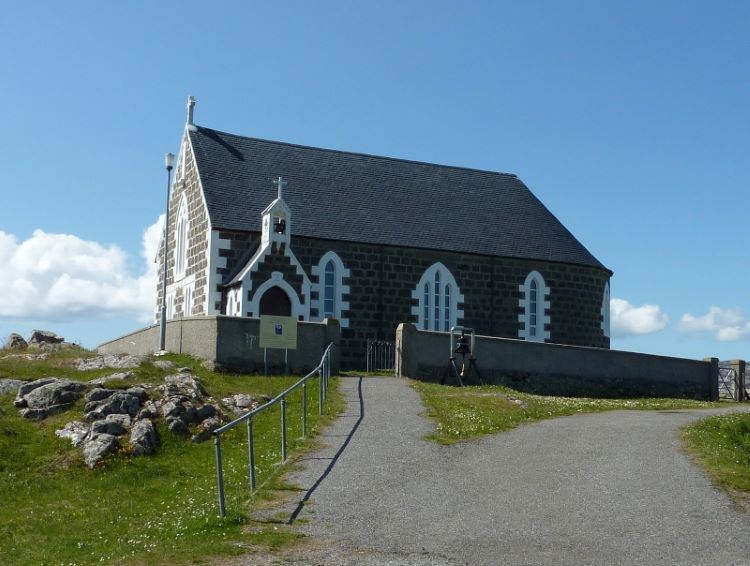Image: St Michael’s Church, Eriskay (Father Allan MacDonald’s parish) https://en.wikipedia.org/wiki/St_Michael%27s_Church,_Eriskay#/media/File:St_Michael’s_Church,_Eriskay_20090608.jpg Licensed CC BY-SA 3.0
Soundyngs directs readers to a new website by Frances Wilkins (University of Aberdeen), opening up her ‘Sacred Soundscapes’ project recording the music of faith communities in the Highlands and Islands.
This work connects with this researcher’s earlier work on gospel and revival singing in North-East Scotland, extending her expertise in the links between faith and song to the Gaelic speaking parts of Scotland.
Wilkins has published in Scottish Studies recently on her research particularly looking at the response in the Presbyterian Hebrides to ‘reawakenings’, or evangelical revivals (see Further Reading, below): that article sits within an even broader context of investigation.
An exhibition touring between Lewis, Skye and Uist between January 2024 and December 2025 is showcasing findings, audio recordings, a film and books and other material associated with sacred singing in the north and west. For those not able to brave CalMac’s transport options within that window, there is also a new dual-language (Gaelic-English) website, including a sound archive of over 300 songs. An interactive sound map takes you to both musical material and maps, images and sometimes videos of the places and people associated with these songs.
The research covers both the psalm singing of the reformed Presbyterian tradition, and also the Gaelic hymns developed by the Catholic communities in places where those older faith practices survived.
Both communities experienced periods of revival in the 19th and early 20th centuries, which left distinctive legacies.
The curation of material from the psalm-singing Protestants includes memories of domestic daily singing within families, encouraged by contact with evangelicals such as Ira Sankey in the later 19th century, and the ‘psalm boat’ singing associated with congregational gatherings for communions. Soundyngs was also interested to learn more about female precenting and psalm singing – mostly outside of formal church worship. Precenting (leading congregational singing) is almost always done within a service by men; however, women with this skill included Murdina MacDonald from Ballantrushal on Lewis, who was recorded by many ethnomusicologists including Francis Collinson, and whose voice is preserved in the archive of Tobar an Dualchais.
Post-Jacobite and Clearance politics shaped the emergence of Gaelic Catholic hymn composition, and in a recent talk for the Vaughan-Williams Library (14th February 2024), Dr Wilkens highlighted ways in which the creation and curation of this repertoire was encouraged by priests such Father Allan MacDonald (1859-1905), a poet, folklorist and champion of crofters against clearance landlords. MacDonald’s anonymously published work included anthologies of Gaelic hymns (1889 and 1893) with both his own lyrics and material collected from local singers from Benbecula, Eigg, South Uist and Eriskay. MacDonald’s collections came to the attention of 20th century folklorists such as John Lorne Campbell, while MacDonald’s compositions in Gaelic for liturgical use continued to form part of local Catholic worship for many decades before the Second Vatican Council normalised vernacular language in the Mass from the 1960s.
Soundyngs wishes Dr Wilkins a fair wind in continuing this work – the website is lovely!
Further Reading and resources
- Seinn Spioradail website
- Father Allan Macdonald – published anonymously – Laoidhean Caitliceach Airson Chloine (Oban, 1889) – digital scan available from the University of the Highlands and Islands
- Father Allan Macdonald – published anonymously – Comh-Chruinneachadh de Laoidhean Spioradail (Oban, 1893) – the source of e.g. the Christmas hymn “Tàladh Chriòsda” – digital copy from the National Library of Scotland
- Recordings of Murdina Macdonald of Lewis, in Tobar an Dualchais
- Frances Wilkins, ‘Singing and the Dùsgaidhean: The Impact of Religious Awakenings on Musical Creativity in the Outer Hebrides‘, in Scottish Studies 40 (2024), pp. 111-124. doi: 10.2218/ss.v40.9292
- Frances Wilkins, ‘Gaelic Psalm Singing: Why the Ancient Tradition is in Danger of Disappearing’, The Conversation, 22 August 2022, accessed 26/2/24

